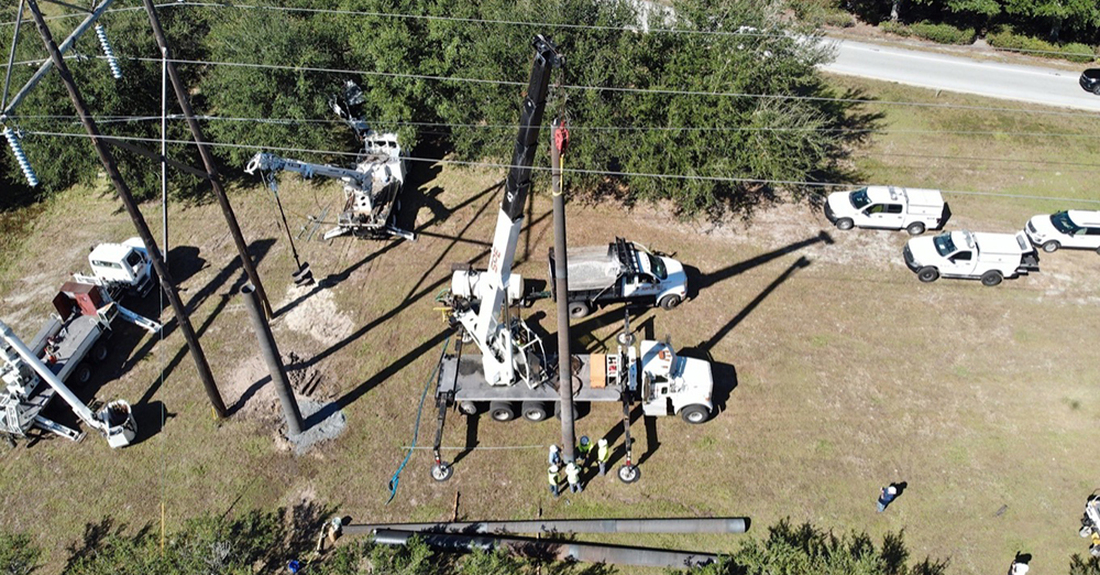
Power poles are fundamental to infrastructure of a range of electrical providers such as investor-owned utilities (IOU), rural electric cooperatives and municipality owned utilities. Pole setting requires careful planning, adherence to safety protocols, and regulatory compliance for their stability and longevity. Here’s a look at the entire process to help power providers conduct safe and effective installations.
Site Assessment and Planning
The first steps of the pole setting process include site assessment and planning to lay the groundwork. Technicians evaluate the site to address potential issues and confirm the safety of the setup.
Evaluating the Location
Technicians first examine the terrain and soil composition at the intended site. Soil stability and type and ground structure affect how well the pole will stand after installation. Identifying rocky, clay-rich, or sandy soil allows technicians to adjust their planning and design.
Identifying Utility and Environmental Factors
Locating underground utilities, such as gas, water, and communication lines, is essential to minimize risks. Utility mapping prevents damage during excavation, while environmental assessments ensure compliance with regulations that protect sensitive areas. The evaluation is one of the many key steps in the pole setting process.
Obtain Necessary Permits and Approvals
Power companies need permits and regulatory approvals to meet federal and local safety standards. Obtaining these supports legal compliance and protects workers and the public.
Understanding Permit Requirements
Power providers must secure permits for pole installations, which often include zoning, safety, and environmental requirements. Companies typically submit applications detailing site plans, impact assessments, and compliance with codes to avoid legal complications and project delays.
Navigating the Approval Process
After applying for permits, companies may undergo regulatory inspections to verify compliance with standards. Preparing documentation and responding promptly to regulatory requests can streamline the process.
Prepare the Site
Once the necessary approvals are in place, technicians clear and prepare the site for installation. Clearing the area of vegetation and obstacles creates an open workspace that supports an efficient setup.
Clearing and Leveling the Area
Clearing the installation site reduces potential hazards and ensures technicians can move equipment freely. In some cases, excavators or bulldozers may be necessary to clear large obstructions. Leveling the ground creates a stable base and prevents the power pole from tilting or shifting after installation. McWane’s ductile iron poles often require less site modification thanks to their consistent sizing and structural stability, making installation easier even in rocky or flood-prone terrain.
Marking the Pole Position
Technicians use stakes and markers to designate the pole’s exact position and align it with other infrastructure, such as power lines and connected utilities. Markers guide the team during installation and encourage consistent alignment when installing one or multiple poles.
Conduct the Excavation Process
Excavation prepares the ground for pole placement and ensures the pole is buried to the correct depth and diameter for structural support. Proper burial is also essential to allow ground line protection systems, such as coatings or wraps, to perform as designed, helping to prevent premature wear, corrosion, or failure at the most vulnerable point of the pole.
Digging the Hole
Technicians calculate the hole’s depth based on the loading design of the structure. Standard burial depth is 10% if the total pole length plus 2’. Specific loading requirements can impact the depth of bury. The diameter of the hole is based on the pole’s base diameter. Heavy-duty augers and digging tools allow for precise control, especially in areas with hard or rocky soil. Adequately sized holes prevent the pole from shifting or becoming unstable over time.
Managing Soil and Groundwater Issues
In areas with loose soil, the installation team will reinforce the pole hole with gravel or concrete. Reinforcement stabilizes the base, helps the pole withstand environmental factors, and reduces future maintenance. In cases where groundwater presents a problem, technicians install drainage solutions to prevent water buildup that could compromise the foundation.
Power Pole Installation
Placing the pole in the excavated hole requires careful positioning and alignment. Technicians use lifting equipment to set the pole in place.
Positioning and Aligning the Pole
Technicians align the pole with previously set markers, ensuring it is relative in position to other structures. Alignment is essential for uniformity, particularly when setting multiple poles along a power line.
Using Lifting Equipment
Crane or hoist operators will lift and position the pole within the hole, which reduces physical strain on workers. The use of lifting equipment also prevents damage during placement. For large or tall poles, specialized lifting tools make the process efficient and safe.
Secure and Stabilize the Pole
Securing the pole is important for the sake of stability and performance. This process involves backfilling, compacting, and reinforcing the foundation to keep the pole steady and prevent future movement.
Backfilling and Compacting the Hole
After positioning, technicians backfill the hole with soil, gravel, or concrete to stabilize the pole. Compacting tools eliminate air pockets within the fill material, which enhances stability and structural integrity. This process prevents the pole from shifting due to environmental factors, such as inclement weather.
Installing Guy Wires for Added Support
Guy wires can be attached to a pole to add strength that is necessary if the calculated load is greater than what the strength of the pole offers by itself. They offer counter-tension that stabilizes the pole against forces that could cause leaning or swaying.
Power pole suppliers, like McWane Poles, offer ductile iron poles known for their strength and resilience in various environments. The reliability of ductile iron poles makes them ideal for power companies seeking to maintain stable infrastructure in various conditions.
Connecting Utilities and Services
Connecting utilities and services finalizes the installation of power poles. Technicians follow safety protocols to ensure these connections operate reliably over the long term.
Establishing Electrical Connections
Technicians attach electrical lines using insulated materials and grounding methods to prevent electrical faults and protect the system. Insulation and grounding reduce the risk of electrical hazards so that the pole supports a safe power distribution network.
Connecting Communication Lines
Communication lines also connect to the pole, requiring careful handling to avoid interference with electrical components. Technicians secure these lines to maintain service quality while preventing accidental damage. Organizing communication and power lines supports system functionality and safety.
Final Inspection and Quality Assurance
A final inspection verifies that each step in the pole installation process meets safety and regulatory standards. Documentation of inspections provides valuable records for future maintenance and quality assurance.
Compliance and Safety Checks
Inspectors review the installation to confirm compliance with federal and local safety guidelines. Addressing issues before finalizing the installation can prevent future complications.
Documentation for Future Reference
Detailed records document installation conditions, component details, and maintenance instructions. Power companies rely on this documentation for ongoing inspections and repairs so that each pole continues to meet safety and regulatory requirements. Accurate documentation also supports transparency.
As you can see, the pole setting process involves multiple steps. All power companies rely on quality materials and detailed processes to uphold infrastructure standards. In a world where wildfires, extreme weather, and rising maintenance costs are everyday challenges, McWane’s ductile iron poles offer a smarter path forward. They resist fire, insects, and corrosion – and require virtually no maintenance. With an estimated lifespan of up to 100+ years, they’re engineered for the long haul. Reach out today to explore reliable solutions for your power infrastructure needs.

